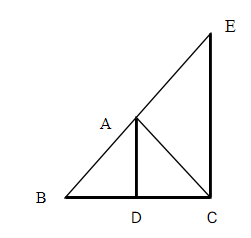
Prove that in a triangle, the angle bisector divides the side opposite to the angle in the ratio of the remaining sides.
Answer
483k+ views
Hint: To prove this, we have to use Basic Proportionality Theorem known as Thales Theorem. According to this theorem, if a line is drawn parallel to one side of a triangle intersecting the other two sides in distinct points, then the other two sides are divided in the same ratio.
Complete step-by-step answer:
Let
Let AD be the internal bisector of

Step1:To prove:
Step2:Since
Step3:Since AD is the angle bisector of
Step4:From (1), (2) and (3), we have
Step5: In
Step6:
In
So, by Thales Theorem,
Then
Hence, the angle bisector of a triangle divides the side opposite to the angle in the ratio of the remaining sides.
Note: Basic Proportionality theorem was introduced by a famous Greek Mathematician namely Thales. Hence it is also called Thales Theorem. According to him, for any two equiangular triangles, the ratio of any two corresponding sides is always the same. Based on this concept, he gave a theorem of basic proportionality. This concept has been introduced in similar triangles. If two triangles are similar to each other then,
i) Corresponding angles of both the triangles are equal.
ii) Corresponding sides of both the triangles are in proportion to each other.
Complete step-by-step answer:
Let
Let AD be the internal bisector of

Step1:To prove:
Step2:Since
Step3:Since AD is the angle bisector of
Step4:From (1), (2) and (3), we have
Step5: In
Step6:
In
So, by Thales Theorem,
Then
Hence, the angle bisector of a triangle divides the side opposite to the angle in the ratio of the remaining sides.
Note: Basic Proportionality theorem was introduced by a famous Greek Mathematician namely Thales. Hence it is also called Thales Theorem. According to him, for any two equiangular triangles, the ratio of any two corresponding sides is always the same. Based on this concept, he gave a theorem of basic proportionality. This concept has been introduced in similar triangles. If two triangles are similar to each other then,
i) Corresponding angles of both the triangles are equal.
ii) Corresponding sides of both the triangles are in proportion to each other.
Recently Updated Pages
Express the following as a fraction and simplify a class 7 maths CBSE

The length and width of a rectangle are in ratio of class 7 maths CBSE

The ratio of the income to the expenditure of a family class 7 maths CBSE

How do you write 025 million in scientific notatio class 7 maths CBSE

How do you convert 295 meters per second to kilometers class 7 maths CBSE

Write the following in Roman numerals 25819 class 7 maths CBSE

Trending doubts
A boat goes 24 km upstream and 28 km downstream in class 10 maths CBSE

Difference between mass and weight class 10 physics CBSE

Statistics in singular sense includes A Collection class 10 maths CBSE

Who gives recognition to political parties as National class 10 social science CBSE

What is oxen Plural singular plural possessive or singular class 10 english CBSE

Leap year has days A 365 B 366 C 367 D 368 class 10 maths CBSE




